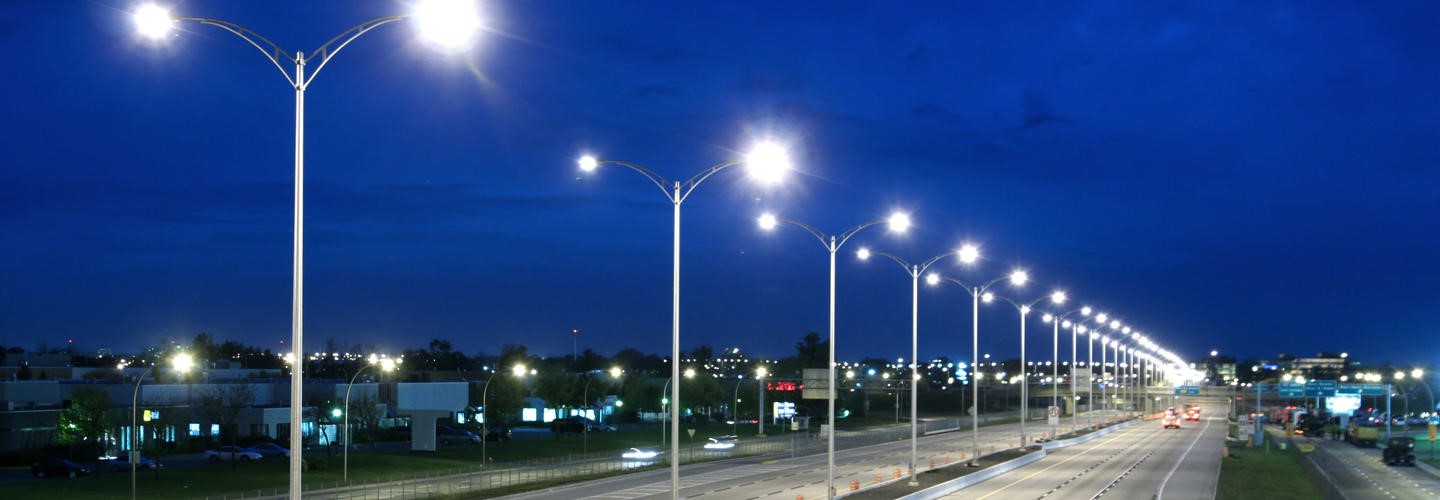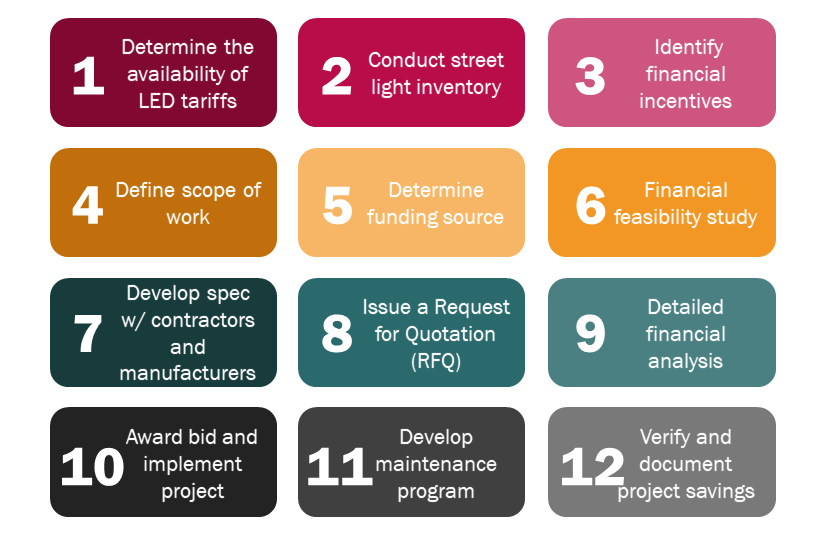The benefits of upgrading conventional, high-pressure sodium, metal halide, and mercury vapor street lights with LED technology offers an array of cost, maintenance, and social benefits, yet cities face ownership, regulatory, tariff, funding, and internal capacity barriers to lighting retrofit projects. SPEER, Department of Energy, and others have explored implementation, benefits, and challenges of streetlighting retrofits at length including the LED Streetlighting and Outdoor Lighting module of our City Efficiency Toolkit. Retrofitting streetlighting remains an important “action” cities can take to support energy efficiency in their own municipal operations, help ensure public safety, and encourage attention to efficiency statewide.

The benefits of retrofitting LED streetlight retrofit projects are well documented*:
- Cost savings: Streetlights can constitute up to 40% of a city’s electricity bill. LED retrofits can reduce energy use by 50%, amounting to substantial cost savings for a city. Furthermore, LED’s last 2 to 5 times longer than traditional outdoor lighting and require less maintenance, reducing operating costs even further.
- Better asset management: Audits of streetlights prepared ahead of retrofits provide cities a clear understanding of their streetlight inventory, distribution of utility and municipally-owned lights, and may enable cities to eliminate some streetlights entirely.
- Advanced controls: LED streetlights are often compatible with advanced controls including, but not limited to, automated dimming which further increases energy savings potential.
- Better Light Quality: LED lamps offer higher-quality color rendering and more uniform light distribution for safer, better lit streets, while newer fixtures can be fully cut off, decreasing light pollution.
- Reduced GHG emissions: Reducing energy consumption reduces associated emissions, thus contributing to the achievement of citywide climate goals.
Despite multiple benefits and tremendous savings, many cities struggle to complete streetlight retrofit projects due to regulatory, tariff, funding, or internal capacity barriers. Primary amongst the challenges is that many streetlights are not owned by the municipality and are often owned by the local electricity distribution utility. Fortunately there are examples of successful city/utility partnership to upgrade lighting. CenterPoint Energy and the City of Houston partnered to convert the city’s street lights to more efficient LED lamps. To date 80 percent of Houston’s 173,000 city lights have been converted to LED street lamps. The project is expected to reduce the city’s consumption of electricity to be reduced by about 70 million kilowatt hours annually. Other cities in the CenterPoint service territory including Manvel, El Lago, Suger Land, and City of South Houston are also engaging with the utility to convert street lights.
Several implementation guides, including one developed by SPEER, offer step-by-step guidance for, and illustrate the business case of, streetlight retrofit projects. A case study of El Paso’s successful retrofit project supports the case for emerging projects. The US Department of Energy offers an array of resources and tools to guide decisions, draft specifications, prepare financial analyses, and analyze outdoor lighting retrofit projects.
* Adapted from Regulatory Issues and Approaches to Municipal LED Street Lighting Conversions
LED Street Light Retrofit Implementation Guidelines and Business Case
A number of implementation guides have been developed to assist cities in planning and executing upon street light retrofit projects while maneuvering regulatory and financial barriers. The process described below represents a combination of various implementation guides and can be modified depending on a city’s needs and project scope.

1. Determine the availability of LED tariffs
Cities should consult with the local electric utility to understand rates and charges that apply to municipally-owned and utility-owned street lights, clarifying how tariffs are distinguished between LED and conventional street lighting technologies. Unfavorable tariffs can substantially limit cost savings from LED lighting retrofits. Refer to section 1.4 of Regulatory Issues and Approaches to Municipal LED Street Lighting Conversions for LED tariff best practices.
2. Conduct a street light inventory
Work with your utility, city finance departments, and/or energy service companies (ESCOs) to assess number and location of street lights, fixture type and wattage, utility vs. city owned, metered vs. unmetered, and maintenance arrangement. ESCOs often include this inventory service in their standard retrofit contracts. The State Energy Conservation Office’s free technical assistance for local governments is also available for lighting inventories. The business case for converting municipally-owned street lights is generally strongest, the Department of Energy’s Street Lighting Acquisition Evaluation Tool helps calculate the financial value of acquiring your city’s street lights from a utility.
3. Identify any financial incentives
Cities should contact the utility’s commercial energy efficiency program to determine availability of incentives for municipal outdoor lighting and street light retrofits.
4. Define the scope of work
It may make more sense for the city to start with a limited retrofit pilot to test various technologies ahead of a full-scale conversion. Cities can the street light inventory to identify critical or highest value retrofit opportunities.
5. Financial feasibility study
Entities can complete a high level financial analysis based on known or estimated energy savings, cost savings from tariffs, and estimated construction costs. If the utility’s lighting tariff is a barrier to the project’s financial viability, cities should prepare a detailed financial analysis to support tariff modification. Refer to section 2.1 of Regulatory Issues and Approaches to Municipal LED Street Lighting Conversions for guidance on the tariff revision process.
6. Determine funding source
LED retrofit projects, like other energy efficiency projects, can be self-funded, financed through SECO’s LoanSTAR revolving loan program, or installed at no up-front cost through an ESCO’s energy services performance contract (ESPC). See the City Project Financing module for more information on financing energy efficiency projects.
7. Develop a specification with input from contractors and manufacturers
Cities will collaborate with contractors, manufacturers, and lighting experts to develop the specification language and test various lighting technologies. This will help to ensure the final bids are well-suited for the project needs. LEOTEK’s A Municipal Guide for Converting to LED Street Lighting offers a sample preliminary specification.
8. Issue a Request for Quotation (RFQ)
Project managers should work with city purchasing departments to comply with procurement procedures. If considering a third-party turnkey contractor or a performance contract, issuing a Request for Proposals (RFP) may be more appropriate.
9. Detailed financial analysis
Quotations and/or proposals conduct a more detailed financial analysis to verify previous financial feasibility assumptions, provide justification to city management, and provide baseline data for future project verification. Cities can use the Street and Parking Facility Lighting Retrofit Financial Analysis Tool to compute annualized energy and energy-cost savings, maintenance savings, greenhouse gas reductions, net present value, and simple payback associated with potential lighting upgrades.
10. Award bid and implement project
Cities select the contract based on various factors, including results from pilot tests, up-front cost, warranty and maintenance packages, contractor reputation, and other selection criteria specific to the city’s procurement standards.
11. Develop long-term maintenance program:
Due to their much longer useful life as compared to conventional technologies, LED Street lights may not align with a city’s standard maintenance practices. In this case, cities should develop a long term maintenance program that involves spot-replacement of components and luminaire cleaning as detailed in LEOTEK’s A Municipal Guide for Converting to LED Street Lighting.
12. Verify and document project savings:
Entities collect data to verify estimated savings based on detailed financial analysis. Savings should be captured in terms of energy and cost as well as social impact metrics, like GHG emissions reductions.
Implementation Resources
The following implementation resources provide further detail on the steps outlined above.
- Street Lighting Retrofit Implementation Guide and LED Street Lighting Business Case, SPEER, May 2017
- A Municipal Guide for Converting to LED Street Lighting, LEOTEK, February 2016
- Regulatory Issues and Approaches to Municipal LED Street Lighting Conversions, US Department of Energy Better Buildings, February 2017
- Street and Parking Facility Lighting Retrofit Financial Analysis Tool, DOE Municipal Solid-State Street Lighting Consortium, Clinton Climate Initiative (CCI)/C40,Federal Energy Management Program (FEMP), and DOE Better Buildings, Revised March 2017
Case Study: City of El Paso’s LED Streetlight Retrofit
The City of El Paso was one of the first cities in Texas to implement an LED outdoor lighting retrofit project. The city’s lighting upgrade took place in multiple phases, and the process involved converting streetlights, traffic lights, and downtown decorative lights to LED lighting.
El Paso expects to save over $2.4 million per year in energy and maintenance costs as the result of upgrading its outdoor lighting to LEDs. El Paso’s successful project serves as an example for local governments who are exploring an LED street lighting retrofit.
Read the City of El Paso’s LED Streetlight Retrofit case study here for more information on the city’s process, challenges, costs, and expected payback of the project.